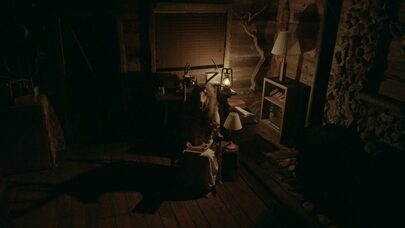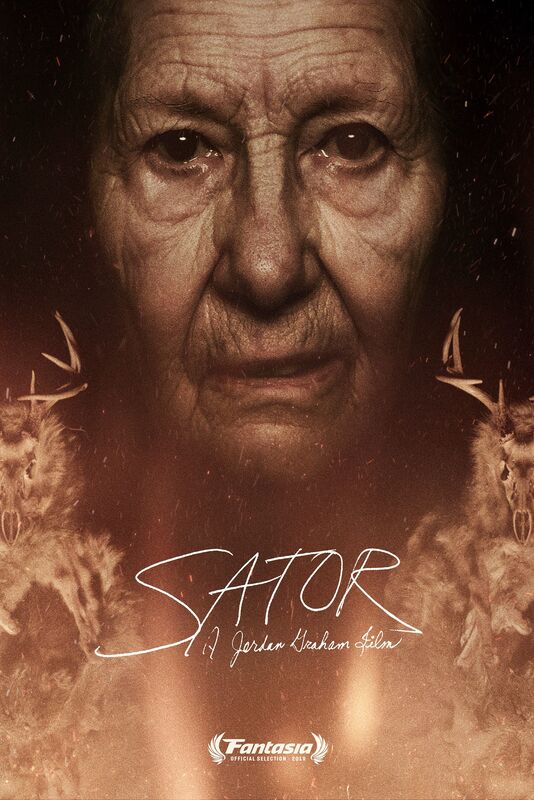 Dazed and confused and deeply unnerved. Playing at Fantasia 2019 today, that’s how minimalist horror film, Sator, leaves you feeling by the end of the strange experience that is watching it… …A true “do it yourself” horror film, writer/director Jordan Graham (Specter) presents a horror flick in Sator which he also shot, edited, and did the score for, making this thoughtful nightmare all that much more impressive. A deeply personal story which is light on dialogue and heavy on atmosphere, Sator revolves around Adam (Gabriel Nicholson) living out in isolation in the woods where he spends his days looking at deer cam photos. Occasionally visited by his brother, Pete (Michael Daniel), Adam notices that Pete has begun to act a lot like their grandmother, Nani (June Peterson), who has long claimed that she speaks to a presence in her mind referred to only as Sator, a presence which now threatens Adam and his entire family. Sator opens with us looking through the lens of black and white home video footage, depicting a lonely forest with mist that rises up like the cold breath of giants. We then find Nani, hanging out in her room in a scene reminiscent of the opening to Hellraiser, surrounded by flickering candles, with eerie satanic whispers filling the space. The moment is filled with an uneasy dread which Graham masterfully weaves all throughout Sator. Similar to The Witch or Hereditary, it’s the sort of meditative horror that is overwhelmingly hopeless from the very beginning. We know we’re in for something truly macabre, and Graham gives us that, with mixed results. The thing about Sator that you’re either going to love or hate is how disorienting it is. Playing out like a haunting dream, Graham doesn’t allow the viewer to get a firm grasp on the sense of time or place in Sator. All throughout, the film switches from a modern look, to a condensed black and white frame, without always being clear on whether or not these black and white images are from the past or present. Set in a desolate loneliness where Adam and Pete spend their days hunting, eating out of cans, and looking at deer cam photos on an out of date computer, there is very little sense of the world around them. Like It Follows, Sator foregoes any references to technology outside of the clunky computer, allowing the film to feel timeless. Graham’s film has you actively working to figure out what is going on here, and, while that can be frustrating, Sator is less about the plot, and more about the chilling experience. That mist that bellows up from the trees is an important element of Sator. Watching Sator, I felt like I was trapped in that mist with Adam and Pete, with a strange fog coming over my mind and lulling me into a strange hypnosis. The lack of plot and dialogue make other aspects of the film stand out that much more, such as the slow, methodical camera movements that creep around corners and through the trees. Like a dream, nothing seems natural. Characters are suffocated by a darkness that threatens to swallow them up. Some of the very few sounds are those of night crickets chirping, and a cacophony of satanic whispers that are so genuinely creepy, I’m actually nervous to play them backwards…but I might, because I’m every curious moron in a horror film. Sator is what I’m calling “sleepy-scary” for now, but don’t take that as me saying this film is dull. Far from it. But because we’re lulled into this hypnotic haze of darkness accompanied by the sounds of crickets chirping and hardly a breath of character development, Sator is this earthy, spiritual beast that puts you under a hypnosis, occasionally shocking you right back into reality by scaring the ever loving shit out of you. Visages of humanoids wearing the skulls of deer and old women floating in the air will do that. Sator goes through long valleys of eerie contemplation, but when it hits brief peaks of horror, it hits them hard. This is a film that takes it’s time working its way beneath your skin, until, before you know it, it’s slithering down your spine like a waterslide. What really resonates with Sator though is its deeply personal nature. I’ve had my own experiences with grandparents suffering from dementia, and it really is one of the most awful diseases there is. So, when Nani talks about “Sator” and the things he says to her, despite not being able to remember his face, it reminds me of my own grandparents repeating things I had said to them, without remembering that I had said them. You begin to feel as if someone with dementia isn’t really there with you, and when they say things as Nani does, you wonder, who really told her that, because it couldn’t have actually been some malevolent spirit, right? So, the true horror of Sator isn’t the unflinching violence or supernatural entities, it’s the existential dread we all feel from knowing that we, too, will someday be faced with dementia, one way or another. And with Pete’s slow decline into the same mind frame as Nani, Sator is an expression of that horrible knowledge that dementia is something terrible which is passed on, like a curse. Like Sator. Sator is an odd experience that, intentional or not, briefly gives the viewer the horrible experience of dementia. We never quite connect to characters, time never really seems to make sense, and whispers from some unknown voice we can’t put a face to constantly fill our heads. Sator won’t work for everyone due to its semi-experimental nature and tired though atmospheric energy, but those with the patience to stick it out will have a nightmarish experience you won’t soon forget. By Matt Konopka
0 Comments
Leave a Reply. |
Archives
March 2023
|



 RSS Feed
RSS Feed